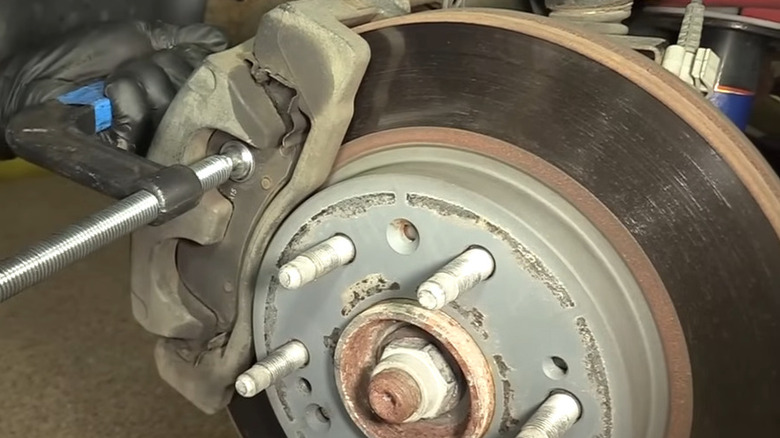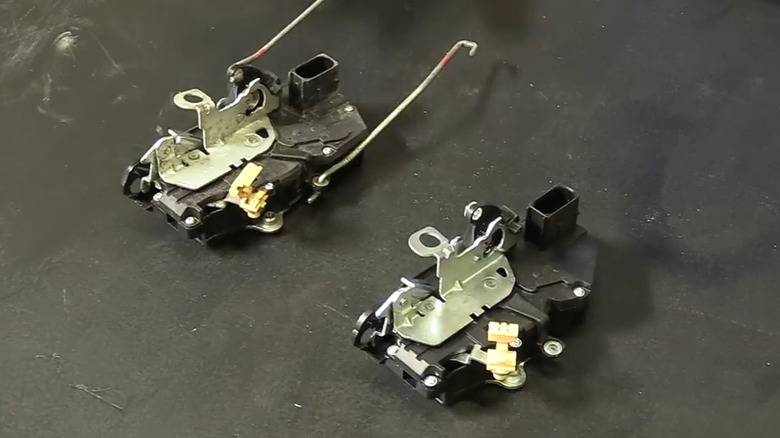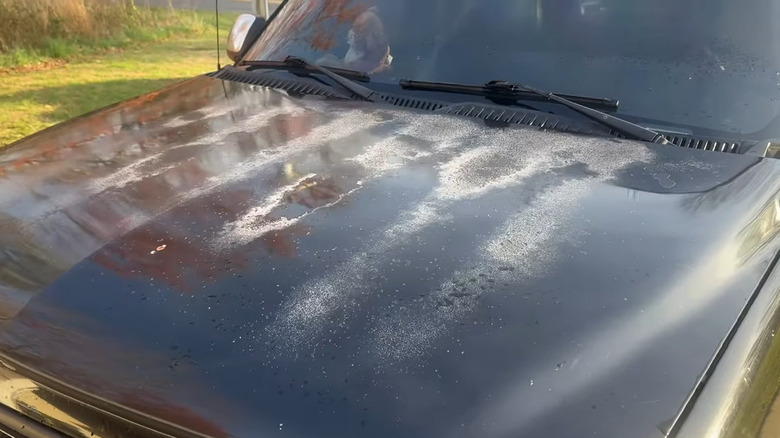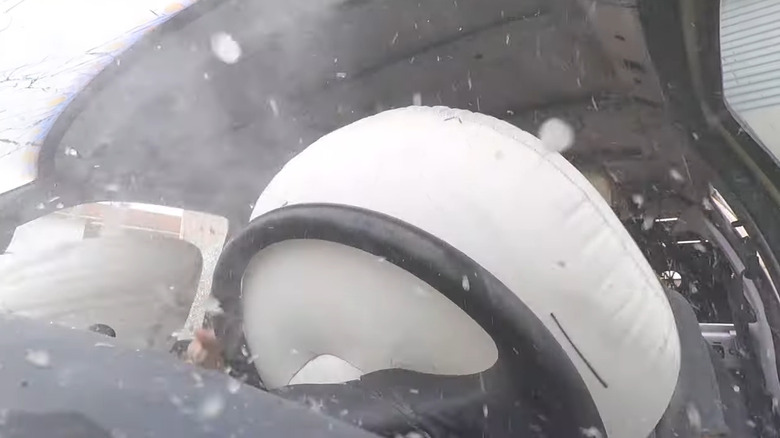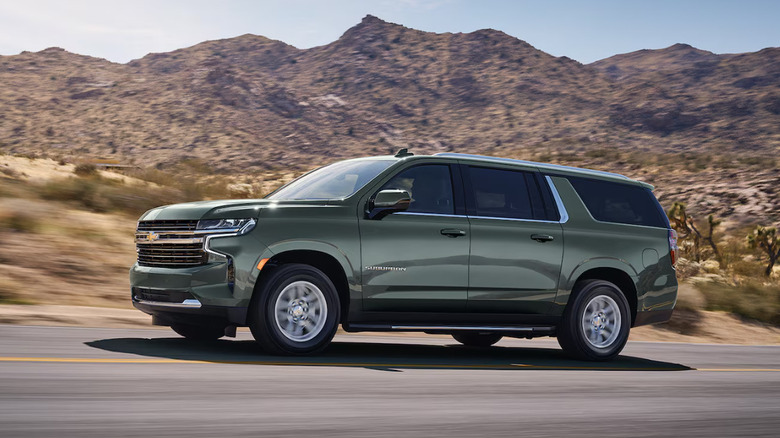Common Problems That Can Happen With The Chevy Suburban (According To Owners)
We may receive a commission on purchases made from links.
America's longest running model has undergone some significant changes over its nearly 90 years of existence. The "Suburban Carryall" started out as a station wagon body slapped onto a full-size truck frame, and was one of the first vehicles to benefit from an all-steel body in a time when wood was the norm.
Oddly, when Chevrolet first began rolling out Suburbans in 1935, the automaker did not trademark the nameplate. Because of that oversight, it wasn't until Plymouth stopped making a station wagon with the same name in 1978 that Chevy's became the lone Suburban on the market.
These days, the Suburban has evolved to combine a spacious and luxurious interior, a serious-looking exterior, and an available 420 horsepower, 460 lb-ft torque V8 engine under the hood. But these vehicles aren't without their issues — this list will run down some of the common problems that can happen with the Chevrolet Suburban, according to owners. This isn't meant to dissuade you if you've got your heart set on one of the most popular vehicles in America. Rather, much like with SlashGear's other "common problems" articles on the Toyota Prius and Honda Ridgeline, we're trying to keep you informed about issues worth looking out for when researching that next big vehicle purchase.
Brake Issues
Brakes are often considered a maintenance item, like tires or oil changes, but they are so much more than that. Brake issues are more than just annoying squeals or pads that need replacing — they're often dangerous and complicated problems that need to be repaired quickly, before drivers endanger themselves and others. Yes, pads wear down and rotors warp. But when brake lines are at risk due to poor engineering, that's a bigger problem, and one that could potentially lead to an accident due to brake fluid loss.
Brake problems are especially prevalent in the ninth-gen Suburban, helping earn that generation 11th place out of 12 in SlashGear's ranking of Chevrolet Suburban generations. Chevy has issued several recalls related to Suburban brake issues, including ABS issues stemming from wheel speed sensor corrosion, brake pedals disengaging because vehicles were sold without a brake pedal pushrod retainer (!), brake lines getting too close to a crossmember and becoming damaged, and hydro-boost problems that resulted in harder brake pedals.
Given that those brake issues were addressed by manufacturer recalls, many will have been taken care of either by the previous owners or the dealership. However, given the serious nature of these issues, verifying which recalls are related to the Suburban model year you're looking at is important, whether it's your vehicle or one you're looking to buy.
Power Lock Failure
The most common Suburban issue reported on Repair Pal's site is an actuator failure for power door locks. Owners of Suburbans from 1990 through 2014 have logged complaints on the site, with mileages ranging from under 20,000 to over 375,000. While the actuator itself isn't terribly expensive — parts and labor generally run under $300 for the job — repairs can be time consuming due to the amount of work involved in diagnosis.
Power lock failure has not been addressed as a manufacturing failure, and as such it hasn't been the subject of a recall. And while simply pressing the power lock button can occasionally produce a noise that points a technician in the right direction, proper diagnosis requires checking for power and ground at the source. That means removing door panels, weather protection, electrical connections, and body clips to access the lock actuator and test power connections.
As is often the case with parts that are hard to access, the testing of a power lock actuator is simple. It's getting at those power connections that's the time suck, often taking over an hour just to get to the point where a Power Probe or similar testing device can be used. Once the problem is verified, it's usually just a matter of repairing a connection or replacing the failed actuator, and putting everything back together again.
GM Security Problems
Car alarms and other anti-theft systems have been around almost as long as vehicles themselves. Given that a car is the second-biggest purchase many people will make in their lives, after a home, it makes sense that one would want to protect their investment. Removable steering wheels were available as early as 1900. Locks, alarms, immobilizers, and trackers would follow, both in aftermarket form and directly from vehicle manufacturers.
General Motors has a history of providing proprietary theft deterrent systems in its vehicles. Those security systems have a reputation for causing problems for owners, whether it's the VATS, Passlock, or Passkey system. If you own a vehicle that utilizes one of these security systems, rest assured that you won't be the first person to encounter issues. Problems with GM's immobilizers are common among not only Chevrolet Suburbans, but all General Motors makes and models.
Fortunately, several enterprising folks have figured out solutions to these problems, and shared them online. There are bypass kits and YouTube videos available for those DIYers who aren't afraid of a little amateur wiring modification. Technicians also often encounter problems with these security systems after replacing ECM, PCM, or body control modules. Solutions range from leaving a key in the ignition to reset the security light to replacing the entire cylinder. In fact, there are entire businesses dedicated to providing bypass modules to customers having problems with their GM security systems.
Wheel Bearing Wear
Bearing wear can grow from an annoyance to a true safety issue in a relatively short time. What starts as a noise can quickly become a vibration, grind, or wheel wobble, and if it isn't addressed, it can cause damage to the differential, suspension, and more.
Most drivers aren't aware of bearings at all, much less the telltale noises that they make. A wheel bearing connects a wheel to its axle, but also allows the wheel to rotate smoothly by way of ball bearings housed inside the unit. The bearing also bears the radial and axial loads that are constantly changing when a vehicle accelerates, stops, or turns. Any vehicle can have an issue with wheel bearings, but Chevy Suburbans made between 1993 and 2013 are particularly well known for their bearing issues.
When presented to a capable technician, bearing noises and vibrations are fairly easy to diagnose — in my experience, a test drive with the windows open is often enough to figure out what the problem is, and which wheel bearing has failed. The replacement of a Suburban's wheel bearing is one of the easier suspension jobs out there, since the whole assembly is replaced as a unit. Replacing the bearing this way saves technicians the time and work of pressing out old bearings into a housing, and it also eliminates the risks inherent in re-using any old, worn parts. It also means DIYers have a much easier time doing it themselves at home.
Moving Seats
While not as serious an issue as, say, a worn brake line or a defective air bag, a wobbly seat can be a terrible distraction while driving. Chevy Suburbans have had a few issues with seats becoming more mobile than drivers would like. The solutions to these problems are relatively straightforward, but they're still worth mentioning in a list like this one.
According to an FAQ document issued by the NHTSA, 2021 Suburbans had an issue that was addressed during assembly and required the temporary removal of both front seats. Apparently, those seats weren't always bolted down properly when put back in after the fix was completed. This happened often enough that a full recall had to be issued, with GM inspecting and securing seat bolts as necessary.
That's not the only issue Suburbans have had with their seats wandering around. GM's power seats run on a worm gear, with shims designed to keep the seats locked in place after adjustments that tend to wear out prematurely. While you could take your vehicle to a shop for inspection and repairs, replacement kits with new bolts and shims are readily available on Amazon for under $25. DIY repairs for this issue require few tools and minimal know-how, and videos featuring simple step by step instructions are available online.
Door Handles Wear and Break
One of the most used parts of a vehicle is the door handle — besides the steering wheel itself, is there any other switch or button engaged more often than the lever that allows you to get in and out of the vehicle?
Most manufacturers use chrome-clad or painted plastic for both interior and exterior door handles. These levers are bound to wear out, because of both the frequency of their usage and the fact that plastic and chrome aren't immune to time or wear and tear. The metal levers that connect door locks and release actuators to the door handle are often connected by thin plastic clips as well, making them prone to deterioration and breakage.
Like the actuator issue we previously discussed, door handle replacements are often a straightforward repair made more complicated by the amount of work necessary to access them. While the handles themselves are easy to get at, attaching the relevant connection arms, especially for interior handles, may require disassembling the whole door panel.
The pull handle integrated into the Suburban's arm rest is also notorious for breaking off. Until recently, repair of this part meant replacing the entire door panel. However, aftermarket parts manufacturers have come up with a much more affordable solution — a reinforced version of this part that installs into the old door panel. It's not perfect, but it is a good fix at a fraction of the price of a full replacement.
Interior Cracks
Expanding on the theme of cheap plastics being used in the Suburban, the 10th generation of the venerable SUV has the problem of looking significantly older than it actually is. These vehicles, produced from 2007 to 2014, frequently have large cracks or holes in their dashboards. While General Motors claims that the cracks are simply cosmetic damage, the cheap plastic, possibly over-torqued bolts securing the dash in place, and decision to switch from a multi-piece dashboard to a single large one all seem to have combined to make these vehicles look poorly maintained and worn out.
Sadly, there aren't many good solutions to this issue. A class action lawsuit against GM was dismissed in 2021, and no recalls appear to be forthcoming. Owners are left with fixes like gluing a new dash cover on top of the damaged one, or completely removing and replacing the dashboard. The former solution doesn't fix the issue so much as hide it, and the latter involves a level of know-how many shade-tree mechanics or DIYers simply don't possess.
Paint Peeling
Cosmetic damage isn't limited to the interior of the Chevrolet Suburban — exterior paint fades and peels on several model years of the SUV as well. Owner stories about paint problems on message boards and forums are common, and reports to Car Complaints include specific notes about clear coat failure, fiberglass hood paint fading, black paint oxidizing, and passenger doors rusting out.
Consumer Reports lists the 2016 Suburban on its list of cars most likely to have paint problems, and a technical service bulletin from GM says that Suburbans from 2011 to 2024 can fall victim to peeling and corrosion. Lawsuits have been filed alleging that GM knew about the paint issues on several of its vehicles and sold them anyway. Right now, however, there's little recourse for owners of these vehicles short of having a professional paint shop do the work. Some folks opt to scuff and apply aftermarket clear coats themselves, and while that's definitely a low cost alternative, it is risky to perform that work if you're not used to working with automobile paint — it's a very different process from repainting that garden fence out back!
Air Bag Recalls
Air bag problems have been a huge issue in the automotive industry over the last few years. Manufacturers like Takata and ARC have both seen their products become the subjects of massive NHTSA investigations. Air bag issues are common among Suburbans, and that's a system DIYers and even many experienced mechanics often don't want to mess with. Even with proper training, an airbag is one of the more dangerous components to work on, and given the issues involved in one of the major recalls related to the Suburban, it's easy to see why. I went through that training when I was first learning the trade, and part of it involved actually exploding an airbag during service — a startling experience, to say the least.
A massive 2021 recall affected 1,778,128 vehicles manufactured from 2010 to 2014. Cadillacs, Chevrolets, and GMC vehicles were all involved, but so were vehicles from Acura, BMW, Dodge, Ford, Honda, Toyota, and more. The short version of the story is that the Takata airbags installed in these vehicles used a propellant that could degrade over time, especially in areas with higher humidity and temperature cycling. That degradation could cause the inflator to explode during deployment, and metal shrapnel from that explosion could injure or even kill passengers in the vehicle.
While air bag problems are not a maintenance issue, or one that can be easily fixed, it's important to look into whether or not the recall work was performed if you're looking into the purchase of a Chevy Suburban made between 2010 and 2014. If there's no documentation that the airbag was replaced, it might be time to pass on that particular vehicle.
Excessive Oil Consumption
All vehicles consume oil, and many get worse as they age. However, GM's fourth-generation 5.3 liter V8 Vortec 5300 LC9 engines had enough of a problem with excessive oil consumption that they became the focus of several class action lawsuits against the automaker.
SlashGear's article on the best and worst years of the Vortec 5.3 engine provides a solid explanation of what went wrong with the Vortec, and why some versions are to be avoided. In short, the excessive oil consumption present in fourth-gen Vortec engines owes to a combination of three issues: a faulty PCV valve, defective piston rings, and problems with the engine's active fuel management system. These factors contributed to an engine that used up oil fast enough to cause catastrophic failure, with some Suburban owners claiming that they needed to add a quart of replacement oil every 1500 miles.
A Colorado lawsuit was recently dropped, but the engine's defective piston rings did end up costing General Motors over $100 million in a 2022 federal class action suit. While no recall has been issued, GM has sent out technical service bulletins addressing the issue. Frankly, the best advice to potential Chevy Suburban shoppers might be to simply avoid buying one that uses the Vortec and was made between 2010 and 2014.
Methodology
Sources used for this article include the NHTSA website for complaints and recalls, Repair Pal, Consumer Reports, Kelley Blue Book, Car Complaints, and more. Repair information was provided by my own fifteen years of experience repairing all makes and models of vehicles, including my experience with repairs of every Suburban issue on this list.
The Chevrolet Suburban is a good, large SUV that has a few problems to look out for. For more information on the latest version of the Suburban, check out SlashGear's coverage of the 2025 Suburban's new features, as well as these articles on our first look and first drive of the new SUV.

